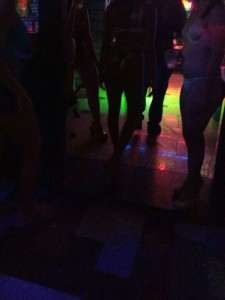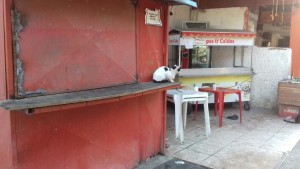 The Prostitution Policy Watch is preparing a report on the effects of the 2016 Rio Olympic Games on sex work in the city. The survey results, which follows a similar study carried out during the World Cup 2014, should only be released in early October, but SPW offers some early evidences and analysis obtained from the fieldwork carried out between July and the end of the Games on August 21. The project is implemented in partnership with the NGOs Davida, Transrevolução, Grupo pela Vidda, ABIA, and the Casa Nem project, with support from the Open Society Foundations for the visual component. The focus is on sexual work practiced by cis and trans women and the study will also follow the Paralympic Games in September.
The Prostitution Policy Watch is preparing a report on the effects of the 2016 Rio Olympic Games on sex work in the city. The survey results, which follows a similar study carried out during the World Cup 2014, should only be released in early October, but SPW offers some early evidences and analysis obtained from the fieldwork carried out between July and the end of the Games on August 21. The project is implemented in partnership with the NGOs Davida, Transrevolução, Grupo pela Vidda, ABIA, and the Casa Nem project, with support from the Open Society Foundations for the visual component. The focus is on sexual work practiced by cis and trans women and the study will also follow the Paralympic Games in September.
 With about 30 people integrating the team, among them sex workers, researchers and an audiovisual team that is working on the visual dimension of the ethnographic project. This team supports a group of 13 sex workers to document, through digital images and audios, their daily lives inside and outside work to bring their direct perspectives of what it is like to work during a “mega-event”. The participants themselves will curate a virtual exposition, that is expected to be online by November.
With about 30 people integrating the team, among them sex workers, researchers and an audiovisual team that is working on the visual dimension of the ethnographic project. This team supports a group of 13 sex workers to document, through digital images and audios, their daily lives inside and outside work to bring their direct perspectives of what it is like to work during a “mega-event”. The participants themselves will curate a virtual exposition, that is expected to be online by November.
Below, some data and preliminary perspectives by the research team, which point to a greater supply than demand, that, similar to the 2014 World Cup, frustrated workers and owners for not even coming close to their expectations. Moreover, to date, the research team estimates that the Olympic Games did not bring the same kinds of violent state repression that they observed during the 2014 World Cup, although episodes of discrimination were reported. The images in the text are from the participant-photographers in the visual component of the project.
What is the initial assessment of the Games’ impact on the sex trade in the city? What kind of effects occurred on demand?
Our initial perception is that there were no major changes in sex work contexts due to the Games. The offer was much higher than demand, and in general, the higher supply did not seem to generate more demand. So far, the vast majority of women have a negative assessment about the games, as do the vast majority of owners whose expectations were not met. But it is still unclear whether this is because there was a decline in sex work during the period or because the games did not notably improve the number of clients. It is important to note as well that this varies from location to location.
There was only one place in the city, Barra da Tijuca, that seems to have experienced an increased demand and number of women working. But it is important to note that this is more a matter of sex workers and clients concentrating in one place, and not a real increase. For example, another point in Barra da Tijuca itself was very empty during the games. We noticed a large amount of mobility; the games prompted some shifts in the city’s sexscape, with prostitutes from downtown and Vila Mimosa working at Copacabana and Barra da Tijuca at night, which is a result of the how the games, and where tourists stayed, were organized throughout the entire city.
What difficulties and threats were noted in relation to the exercise of the activity? There were reports of violence or repression?
We heard that the police were expelling prostitutes from the streets of access to the Maracanã stadium, however it is difficult to know whether this was an anti-prostitution measure or a pro-security effort in general. Apart from that, it seems that the games had less repression in prostitution areas than in the World Cup. We also noticed a reduction of overt police presence in prostitution points, compared to the World Cup.
difficult to know whether this was an anti-prostitution measure or a pro-security effort in general. Apart from that, it seems that the games had less repression in prostitution areas than in the World Cup. We also noticed a reduction of overt police presence in prostitution points, compared to the World Cup.
We are still uncertain about the police operation against the alleged “pedophilia agency” near the Olympic village. Although portrayed as sexual exploitation of children, it is important to note that this excuse is always mobilized in anti-prostitution operations and, for now, the police have only accusations and circumstantial evidence, without any arrested explorer or rescued child. We will do interviews with those involved in these operations to clarify what happened.
On the other hand, we saw and heard some “whorephobia”, especially in locations where prostitutes circulated in attempts to arrange programs outside “traditional” prostitution points. In Ipanema, for example, we witnessed aggression and symbolic violence by Brazilian women who were not working against sex workers in bars that are not known for prostitution. We also heard narratives of abolitionist rhetoric used by men to justify the non-purchase of sex. Many sex workers have commented negatively about their experiences in trying to circulate in areas that they qualify as “playboy”, like Mauá Square, The Praça 15 and the bars of Ipanema. In other words, it seems that more sex workers in these spaces may have generated higher levels of “whorephobia” by women and men who were not exchanging sex for money
What parallels, although preliminary, it is possible to draw between the 2016 Olympics and the World Cup 2014? What similarities and differences can be identified in relation to the landscape of prostitution in both mega-events?
It is very important to begin remembering the obvious – sex work happens in Rio during the entire year, not only during the mega sporting events. We noticed that there are several factors that have influenced how sex work configured during this period that need to be taken into account to compare prostitution during the two “mega-events”.
For example, we observed in the months prior to the games that the economic crisis and closure of several downtown houses over the past few years affected the number of women working (more women in less houses). At the same time, the movement before the Games was low due to the economic crisis. The women hoped for the movement to improve during the Games, although given the experience in the World Cup, they doubted that it would (and in fact it did not).
It is also important to note the differences between the two mega-events. In the World Cup, the activities were concentrated in the FIFA Fan Fest and the Maracanã. There was a concentration of tourists in certain places of the city, including the prostitution spots such as Copacabana, while other places were very empty. There were also many holidays in the city that left areas such as downtown and the Vila Mimosa, which are frequented by locals workers, very empty.
In the Olympic Games, there were fewer holidays and activities spread across the entire city, and a much larger number of tourists spread through the city, from Barra da Tijuca to downtown. Unlike the World Cup, there were many activities in downtown and Barra da Tijuca. Copacabana continues as a tourist center, as well as some local competitions – as we mentioned before, this was also reflected in prostitution. The movement in the Center was slightly better than the World Cup due to the lower number of holidays, yet the Vila Mimosa, once again, was largely empty.
In short, our initial observations and considering the entire city seem to indicate that the movement was not as bad as in the World Cup, but in some cases it was “normal”, not coming close to sex workers or owners’ expectations. The effects of the Games were much more spread out than in the World Cup, where we saw a clear concentration of sex workers and clients in Copacabana. At the Olympic Games, concentrations and increases were only seen in a couple of places and houses spread throughout the city; few locations seem to have seen an overall increase in the number of clients and programs, several even reporting decreases. For the Centro (downtown), however, the Olympic Games were not as devastating as the World Cup.
